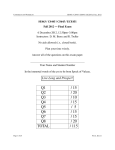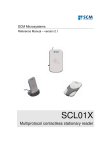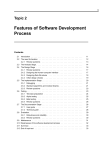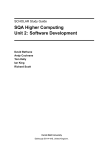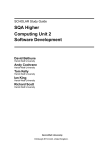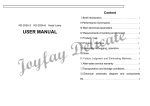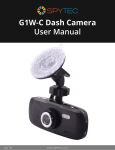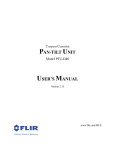Download q1 / 15 q2 / 10 q3 / 10 q4 / 20 q5 / 15 q6 / 20 q7 / 10 total / 100
Transcript
U NIVERSITY OF WATERLOO SE463, FALL 2011 SE463 Fall 2011 — Final exam 17 December 2011, 12:30pm–3:00pm Instructor: Daniel M. Berry No aids allowed (i.e., closed book). Plan your time wisely. Answer all of the questions on this exam paper. Your Name In the immortal words of the yet to be born Jean Luc Picard, Make it so! Q1 Q2 Q3 Q4 Q5 Q6 Q7 TOTAL Page 1 of 23 / 15 / 10 / 10 / 20 / 15 / 20 / 10 / 100 F INAL EXAM U NIVERSITY OF WATERLOO SE463, FALL 2011 1. [15 total marks] Short Answer, Mostly Fill in the Blanks A short underscore of 1 inch (= 2.54 cm) should be filled with one word. A long underscore of 3 inches (= 7.63 cm) should be filled with a phrase consisting of one to several words. In the former case, if you cannot think of exactly the right number of words, then give the best answer that you can and we’ll give it as many points as we can, possibly even full credit! Nonfunctional Requirements (a) For most software, the requirement of may be non. functional, but for real-time software this requirement may be (b) Perhaps paradoxically, the nonfunctional requirement of simplicity may be in direct conflict with the nonfunctional requirement of , but for different issues. RE Methodology (c) The CS lounge microwave oven is too high to allow someone to see if any liquid he or she is nuking is about to boil over so that he or she can turn off the power before a mess is made. The microwave oven was placed on a shelf that is above the eye level of 90% of the population. One could say that this userinterface design error happened because in doing the requirements analysis for the lounge, the analysts forgot to consider some important lounge. for the microwave oven in the RE Reference Model (d) The simplest way to ensure that a state machine diagram of a system remains a pure specification and does not go into implementation details is to insist that all entities of the state machine diagram are entities of the in the world diagram. Real-Life RE (e) The main points of Michael Jackson’s famous quotation “RE is where the informal meets the formal” is that the conversion from raw ideas about a system to be built to code cannot be Page 2 of 23 if indeed F INAL EXAM U NIVERSITY OF WATERLOO SE463, FALL 2011 the code is produced, and the point in the system’s development lifecycle that the conversion happens is called . (f) The main point of “requirements determination is unstoppable” is that if RE is not allowed to run its course to produce a requirements specification that specifies the system to be built completely, then requirements will be determined during the writings of (1) the by the and by the (2) the and neither of these people share the customer’s interests. , Testing and Inspection (g) Each of the various testing and inspection techniques described in the lecture on the topic of “Inspection” are usable not only for validation but also for an inspection for validation and an inspection for X are that 1. The artifacts inspected for a validation are from while the artifacts inspected for a X are from (= X hereafter). Two distinctions between in the system development lifecycle, in the system development lifecycle. 2. The inspection team for a validation usually includes the (= Y hereafter) of the system under development, while the inspection team for a X usually does not include the Y of the system under development. Cost Estimation (h) To use Function Point Counting to estimate the size of a program, one must count the number of times each input, output, and processing operation (pick one of the following by checking its underscore) appears in the code. occurs during runtime. (i) The nice thing about using Function Point Counting to estimate the size of a program during RE is that one can do the counting of input, output, and processing operations from the (kind of document). Page 3 of 23 F INAL EXAM U NIVERSITY OF WATERLOO SE463, FALL 2011 Bidirectional Word Processing, Unicode and Beyond (j) In Berry’s opinion, the major complexity of the Unicode Bidirectional Algorithm could have been avoided by having only (strength) characters and having (number) each of the space, international punctuation, etc, one for each text . (k) The space, international punctuation, etc. are dard . (strength) characters in the Unicode stan- (l) The main difference between Berry’s approach and Unicode’s approach to bidirectional word processing is that Berry insists that the user be aware of the of each character, but Unicode insists that the user should not have to be aware of this information for Each of Berry and the Unicode Committee believe that his or its approach is than the other’s. (strength) characters. for the user (m) If a selection is supposed to select characters that are adjacent to each other in the logically ordered file that is being edited in a bidirectional word processor, then when a selection applied to the visual ordering of a file crosses a direction change boundary the region highlighted by the selection appears to be . (n) A selection applied to the visual ordering of a file crossing a direction change boundary causes cognitive dissonance because: while the hand continues to move in the direction it was moving as the selection crossed the boundary, the region highlighted by the selection grows in the . (o) In the Unicode standard, Arabic letters are stored in the file being edited in logical order (pick one of the following by checking its underscore) in position-shaped, connected, and ligatured form OR in stand-alone, unconnected, and unligatured form. (p) Handling traditional Chinese, Japanese, Korean requires being able to display text with characters flowing top-to-bottom (TB) with lines flowing right to left. To make the Unicode standard tridirectional in the way that it is now bidirectional, what control characters must probably be added? Page 4 of 23 F INAL EXAM U NIVERSITY OF WATERLOO SE463, FALL 2011 2. [10 total marks] Answer True or False. Each incorrect answer is worth the negative of one half the marks that a correct answer is worth; i.e., it’s not worth guessing. Nevertheless, you cannot get less than zero in total. In the following, “SUD” means “system under development”. (a) In the Unicode Standard, international punctuation characters are weak characters. Answer: (b) In the Unicode Standard, international numeral characters are weak characters. Answer: (c) In the Unicode Standard, letters of an alphabet are strong characters. Answer: (d) In the Unicode Standard, all standard size space characters are weak characters. Answer: (e) In the Unicode Standard, there is one standard size space character (ignoring the non-breaking space character). Answer: (f) In the validation condition, D, S ` R for a SUD, D stands for domain assumptions. Answer: (g) In the validation condition, D, S ` R for a SUD, S stands for the SUD. Answer: (h) In the validation condition, D, S ` R for a SUD, R stands for requirements for the SUD. Answer: (i) In the validation condition, D, S ` R, if one cannot demonstrate R for the SUD from D and S , one can try weakening R. Answer: (j) In the validation condition, D, S ` R, if one cannot demonstrate R for the SUD from D and S , one can try weakening S . Answer: Page 5 of 23 F INAL EXAM U NIVERSITY OF WATERLOO SE463, FALL 2011 (k) In the validation condition, D, S ` R, if one cannot demonstrate R for the SUD from D and S , one can try strengthening D. Answer: (l) The validation condition D, S ` R is known also as the verification condition. Answer: (m) In the world diagram, something is in the interface if it is needed to write S . Answer: (n) In the world diagram, something is in the system, excluding the interface if the user needs to be aware of it to operate the system. Answer: (o) In the world diagram, something is in the system if the implementers want to implement it. Answer: (p) In the world diagram, something is in the system, excluding the interface if the user does not need to know it. Answer: (q) In the world diagram, something is in the system, excluding the interface if the user should not be allowed to know it. Answer: (r) In the world diagram, something is in the interface if it is relevant to the system, but the developers do not want to be responsible for building it. Answer: (s) In the world diagram, something is in the world, excluding the environment and the system if it is believed neither to be affected by nor to affect the system. Answer: (t) In the world diagram, something is not in the interface if the user has no access to it whatsoever. Answer: (u) The problem called “PotLoBoaDtiP” is that a necessary document in software development that is painful to produce is that the document has no benefit to its consumer because the consumer is someone other than the producer. Answer: Page 6 of 23 F INAL EXAM U NIVERSITY OF WATERLOO SE463, FALL 2011 (v) A collection of boxes that do not fill up a 53 foot standard shipping container will be loaded into the container by twice the number of people in approximately half the time. Answer: (w) An ice arena will be cleared by twice the number of Zambonis, each of which works in its own half of the arena in approximately the same time. Answer: (x) An ice arena will be cleared by twice the number of Zambonis, each of which works in the whole arena in approximately half the time. Answer: (y) A user’s manual will be written by twice the number of people in approximately twice the time. Answer: (z) A scenario may contain many use cases. Answer: (aa) A use case may contain many scenarios. Answer: (ab) During the first phase of a classical brainstorming session, it is customary to emphasize quality over quantity of ideas. Answer: Page 7 of 23 F INAL EXAM U NIVERSITY OF WATERLOO SE463, FALL 2011 3. [10 total marks] Domain modeling with Class Diagram and World Diagram Recall the domain model of the bidirectional word processor (BDWP) in the form of a UML class diagram with a superimposed world diagram that was presented as Berry’s solution to Deliverable 2 that is reproduced on the next page. (a) Add to this domain model classes for: i. a clipboard which is used to store text which is copied from a selection such as obtained in your use case, a selection that might cross a directional change boundary. ii. a search pattern, which is entered by the user in an input box after he or she invokes the find command through the edit menu or with a shortcut. Put these new classes in the proper place in the diagram so that they are where they should be in the superimposed world diagram. Then draw arcs connecting these new classes to the other classes to which they have access or that have access to them. Page 8 of 23 F INAL EXAM Page 9 of 23 defaultDirection: (LR, RL, Neutral) code: [0..2**32−1] View 1 1 UnicodeFileInLogicalOrder order docDirection Interface position: (SA, CP, CA, CB, Neutral) docDirection: (LR, RL) order: (Logical, Display) selection: pos, pos cursor: pos User <<actor>> Monitor cursor selection Session BiDiWP Keyboard ControlCharacter Pointer code VisibleCharacter Environment defaultDirection UnicodeCharacter n position ShapedCharacter m System U NIVERSITY OF WATERLOO SE463, FALL 2011 F INAL EXAM U NIVERSITY OF WATERLOO SE463, FALL 2011 (b) The data in the clipboard should be stored in which order? (Check the correct answer.) Logical or time order Visual order (c) What is the main implementation advantage of your answer to Question b? (d) If your BDWP had a command that showed the user the contents of the clipboard, in which order should the contents of the clipboard be shown to allow the user to read the contents normally? Logical or time order Visual order (e) The data in the search pattern should be stored in which order? Logical or time order Visual order (f) What is the main implementation advantage of your answer to Question e? (g) In which order should the contents of the search pattern be shown as the user enters the search pattern to allow the user to read the contents normally? Logical or time order Visual order (h) In view of your answer to Question b, of what other class in the original diagram would it be reasonable to consider the class clipboard a subclass? (i) In view of your answer to Question e, of what other class in the original diagram would it be reasonable to consider the class search pattern a subclass? Page 10 of 23 F INAL EXAM U NIVERSITY OF WATERLOO Page 11 of 23 SE463, FALL 2011 F INAL EXAM U NIVERSITY OF WATERLOO SE463, FALL 2011 4. [20 total marks] State machine modeling with State Machine Diagrams A word is a sequence of letters or non-breaking space characters ended by a delimiter, i.e., a space, punctuation, digit, etc. For the purposes of this question, a letter is any character x that triggers the event letter (c) while giving x to c, a delimiter is any character x that triggers the event delim(c) while giving x to c, and a non-breaking space character is any character x that triggers the event nbsp(c), but not delim(c), while giving x to c. In the output, a non-breaking space character looks like the ordinary space that is a delimiter, but it can be inside a word without ending the word. A non-breaking space character cannot be at the beginning of a word. Consider the state machine diagram, SMD1, below that outputs its input, and that adds an “SOW” marker before the first character in each word and an “EOW” marker after the last character in each word. In this diagram, c holds the current character, pc holds the previous character which is already sitting in the output and can be changed, and pc ← c means that the current character becomes the previous for the next transition. letter(c)/"SOW"c; pc<-c BetweenWords InWord delim(c)/c"EOW"; pc<-c nbsp(c)/" "; pc<-c delim(c)/c; pc<-c VAR c: char; VAR pc: char; nbsp(c)/" "; pc<-c letter(c)/c; pc<-c We would like to add to SMD1 the ability to recognize the need for the “fi” ligature. That is, whenever SMD1 sees an “i” immediately following an “f”, SMD1 replaces them with the “fi” ligature. Two pages hence is the skeleton of an extension of SMD1 that does the ligature replacement. This skeleton consists of a copy of SMD1 with the addition of one more state InWordWithF to be gone to whenever an “f” has been seen in the input. In this new state, if the machine’s next input is an “i”, the machine should delete the previously issued “f”, now in pc, and instead of outputting “i”, and the machine should output “fi”. Page 12 of 23 F INAL EXAM U NIVERSITY OF WATERLOO SE463, FALL 2011 Add all necessary transitions and their annotations: event [condition]/ output; commands In these annotations, you may use anything that appears in SMD1 plus f (c) is triggered by “f” while giving “f” to c. i (c) is triggered by “i” while giving “i” to c. pc ¯ means to remove the previous character from the output. Also, if you have two or more transitions out of one state that would be triggered by the same input, be sure to use a “[condition]” on one or more of the transitions to make sure that in fact only one transition can be triggered by any input. If you have to change the annotation on any existing transition, cross off the old one and write the new one near it. Page 13 of 23 F INAL EXAM U NIVERSITY OF WATERLOO SE463, FALL 2011 InWordWithF letter(c)/"SOW"c; pc<-c BetweenWords InWord delim(c)/c"EOW"; pc<-c nbsp(c)/" "; pc<-c delim(c)/c; pc<-c Page 14 of 23 VAR c: char; VAR pc: char; nbsp(c)/" "; pc<-c letter(c)/c; pc<-c F INAL EXAM U NIVERSITY OF WATERLOO SE463, FALL 2011 There is another approach to modifying SMD1 to deal with the “fi” ligature. The number of states is unchanged. Instead, the event and processing associated with some transitions are changed so that when the current character c is “i” and the previous character pc is “f”, the “f” is removed from the output and an “fi” is output instead of an “i”. Modify the state machine diagram on the next page accordingly. Make sure that you deal with every transition that should be dealt with. If you have to change the annotation on any existing transition, cross off the old one and write the new one near it. letter(c)/"SOW"c; pc<-c BetweenWords InWord delim(c)/c"EOW"; pc<-c nbsp(c)/" "; pc<-c delim(c)/c; pc<-c Page 15 of 23 VAR c: char; VAR pc: char; nbsp(c)/" "; pc<-c letter(c)/c; pc<-c F INAL EXAM U NIVERSITY OF WATERLOO SE463, FALL 2011 5. [15 total marks] Ambiguity (a) The “Only” Ambiguity Consider Peter Neumann’s famous example of a sentence with at least 21 different variations obtained by migrating only to all possible places in the sentence, varying the punctuation, adding the word that, and changing emphases when speaking: I said he thought secret users may write secret data. Let’s first add that to the two places where they should be to get I said that he thought that secret users may write secret data. A secret user is a user who has a Secret-level security clearance, i.e., is allowed to work with secret data, i.e., data that are classified as Secret. Some of the variations are (on the next page): Page 16 of 23 F INAL EXAM U NIVERSITY OF WATERLOO SE463, FALL 2011 1. Only I said that he thought that secret users may write secret data. 2. I only said that he thought that secret users may write secret data. 3. I said only that he thought that secret users may write secret data. 4. I said that only he thought that secret users may write secret data. 5. I said that he only thought that secret users may write secret data. 6. I said that he thought only that secret users may write secret data. 7. I said that he thought that only secret users may write secret data. 8. I said that he thought that secret users only may write secret data. 9. I said that he thought that secret users may only write secret data. 10. I said that he thought that secret users may write only secret data. Below are 14 sentences, 10 of which interpret, explain, or exemplify the meanings of the above 10 sentences. Please, in the underscore next to each sentence S above, write the letter labeling the one of the 14 sentences below that best interprets, explains, or exemplifies S . A. The only thing secret users may do with Secret data is to write them; they may not, for example, read them. B. They are permitted to write, but perhaps they are unable to. C. But he wasn’t really sure. D. But not Secret daemon processes or administrators. E. No one else said so. Only I did. F. But they may not read such data. G. They may not write secret procedures. H. I didn’t really mean it. I just said it. I. I don’t think anyone else thought so! J. But they may not write Top-Secret or Unclassified data. K. I didn’t say anything else. L. The writer must be a user, and a Secret user at that, to write Secret data. M. He thought only that, and did not think anything else. N. But not Unclassified or Top-Secret users. Page 17 of 23 F INAL EXAM U NIVERSITY OF WATERLOO SE463, FALL 2011 (b) The Plural Ambiguity The following three sentences appear in at least one document about object-oriented programming: 1. Classes have names. 2. Classes have component classes. 3. Classes have subclasses. The ambiguity in these sentences is that without domain knowledge up front, the reader does not know how many of the direct object entities, i.e., names, component classes, and subclasses, each subject entity, i.e., class, can have. By filling in the blanks below, rewrite each of the three sentences into a sentence beginning with Each that expresses the relationship given with the repetition of the sentence below. Classes have names.: 1 – 1 Each has name. Classes have component classes.: 1 – many Each has component classes. Classes have subclasses.: many – many (because of multiple inheritance) Each of classes shares subclasses. Page 18 of 23 F INAL EXAM U NIVERSITY OF WATERLOO SE463, FALL 2011 6. [20 total marks] The Unicode Bidirectional Algorithm (a) Consider the following sentence and LR document, VO, shown in visual order Dan said “ ”שלום !"مto Dana. Write here the number of the line among the five lines below that is the logically or time-ordered version of VO. 1. Dan said “ ”مالس םולשto Dana. 2. Dan said “ ”םולש مالسto Dana. 3. Dan said “ םולש%&'(” to Dana. 4. Dan said “ ”)*م שלוםto Dana. 5. dias naD “ ”مالس םולשanaD ot. (b) Write here the number of the pair of lines among the two pairs below that is proper breaking of VO into two lines. 1. Dan said, “!"م ”שלוםto Dana. 2. Dan said, “שלום ”!"مto Dana. Page 19 of 23 F INAL EXAM U NIVERSITY OF WATERLOO SE463, FALL 2011 (c) Consider the following sentence LO1 in logical order with the convention that lower case letters are strong L-R characters, upper case letters are strong R-L characters, and the punctuation symbols are themselves. he said: car MEANS CAR. Then show the correct visual order representation of LO1: (d) Consider the following sentence LO2 in logical order with the convention that lower case letters are strong L-R characters, upper case letters are strong R-L characters, and the punctuation symbols other than “[” and “]” are themselves. he said: [car MEANS CAR]. Suppose that “[” is RLE and “]” is PDF. Then show the correct visual order representation of LO2: (e) Consider the following sentence LO3 in logical order with the convention that lower case letters are strong L-R characters, upper case letters are strong R-L characters, and the punctuation symbols other than “[” and “]” are themselves. he said: [car MEANS CAR]. Suppose that, in this case, “[” is RLO and “]” is PDF. Then show the correct visual order representation of LO3: (f) When a bidirectional word processor is processing a logically ordered file, in principle the unicode bidirectional algorithm is carried out on the entire logically ordered file after each to the file. However, an implementation of the bidirectional word processor may make any optimizations that has the observable Page 20 of 23 to the user. F INAL EXAM U NIVERSITY OF WATERLOO SE463, FALL 2011 7. [10 total marks] Linear Temporal Logic (a) Match each numbered formula with the lettered English sentence that most closely captures the formula’s meaning. 1. (A ⇒ 3B ) 2. 2(A ⇒ 3B ) 3. 23A 4. 32A 5. (A ⇒ B ) 6. 2(A ⇒ B ) A. Henceforth A. B. Whenever A then B in the next state. C. Whenever A then eventually B . D. A in the next state. E. Eventually A is permanently true. F. If A then B in the next state. G. If A then eventually B . H. If eventually A then henceforth B . I. A happens infinitely often. J. A and B happen infinitely often. (b) Answer True or False. Each incorrect answer is worth the negative of one half the marks that a correct answer is worth; i.e., it’s not worth guessing. Nevertheless, you cannot get less than zero in total. i. (2(A ⇒ B )) ⇒ (2(A ⇒ 3B )) Answer: ii. (2(A ⇒ 3B )) ⇒ (2(A ⇒ B )) Answer: Page 21 of 23 F INAL EXAM U NIVERSITY OF WATERLOO SE463, FALL 2011 iii. ((A U B ) ⇒ 3B ) Answer: iv. ((A U B ) ⇒ 2B ) Answer: v. (3B ⇒ (A U B )) Answer: vi. (2B ⇒ (A U B )) Answer: vii. (2B ⇒ (A W B )) Answer: viii. ((A W B ) ⇒ 3B ) Answer: ix. ((A W B ) ⇒ 2B ) Answer: x. (3A ⇒ (A W B )) Answer: xi. (2A ⇒ (A W B )) Answer: Page 22 of 23 F INAL EXAM U NIVERSITY OF WATERLOO SE463, FALL 2011 xii. (A W B ) ⇒ ((A U B ) ∨ 2A) Answer: xiii. ((A U B ) ∨ 2A) ⇒ (A W B ) Answer: xiv. 23A ⇒ 32A Answer: xv. 32A ⇒ 23A Answer: Page 23 of 23 F INAL EXAM























